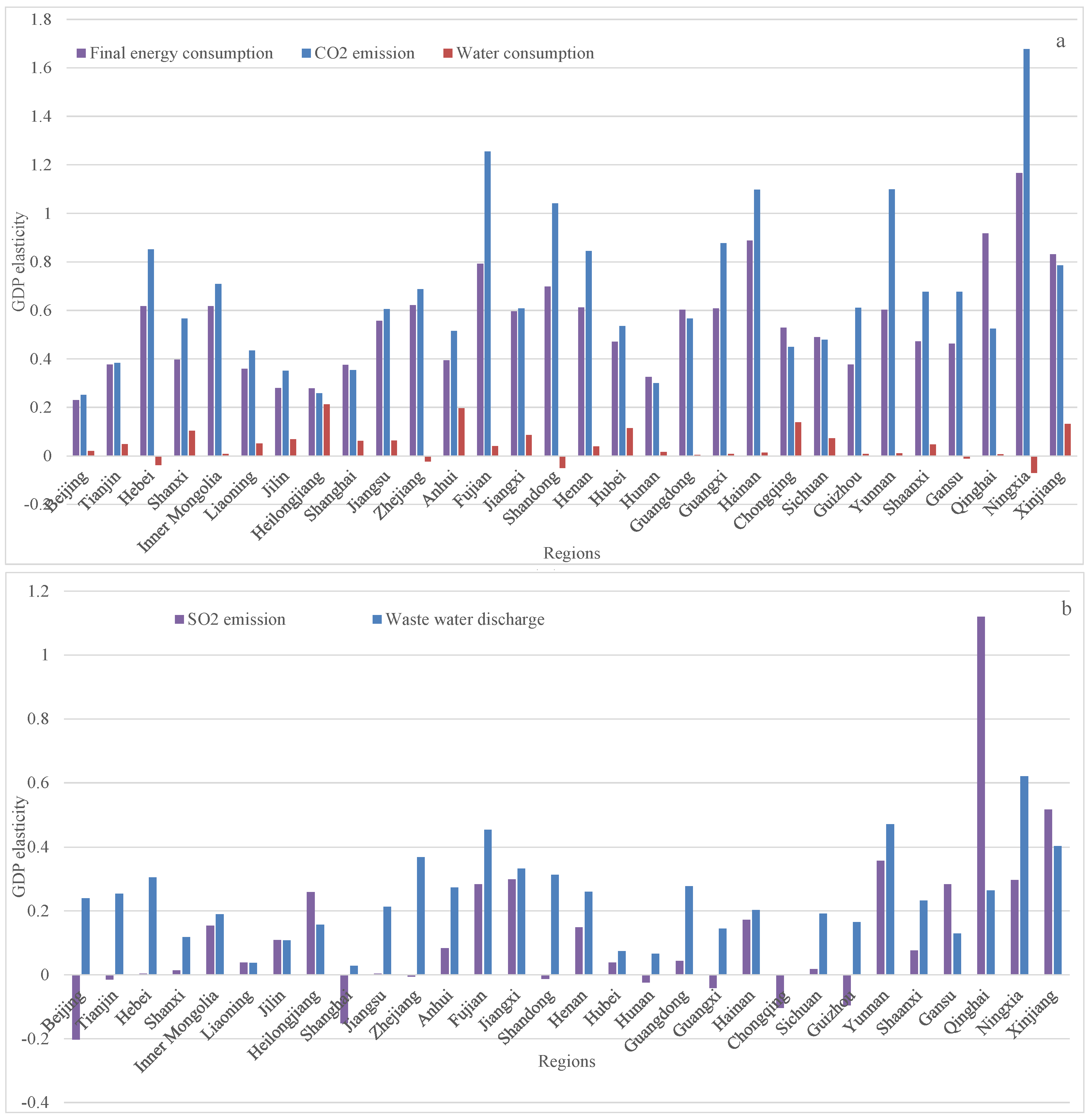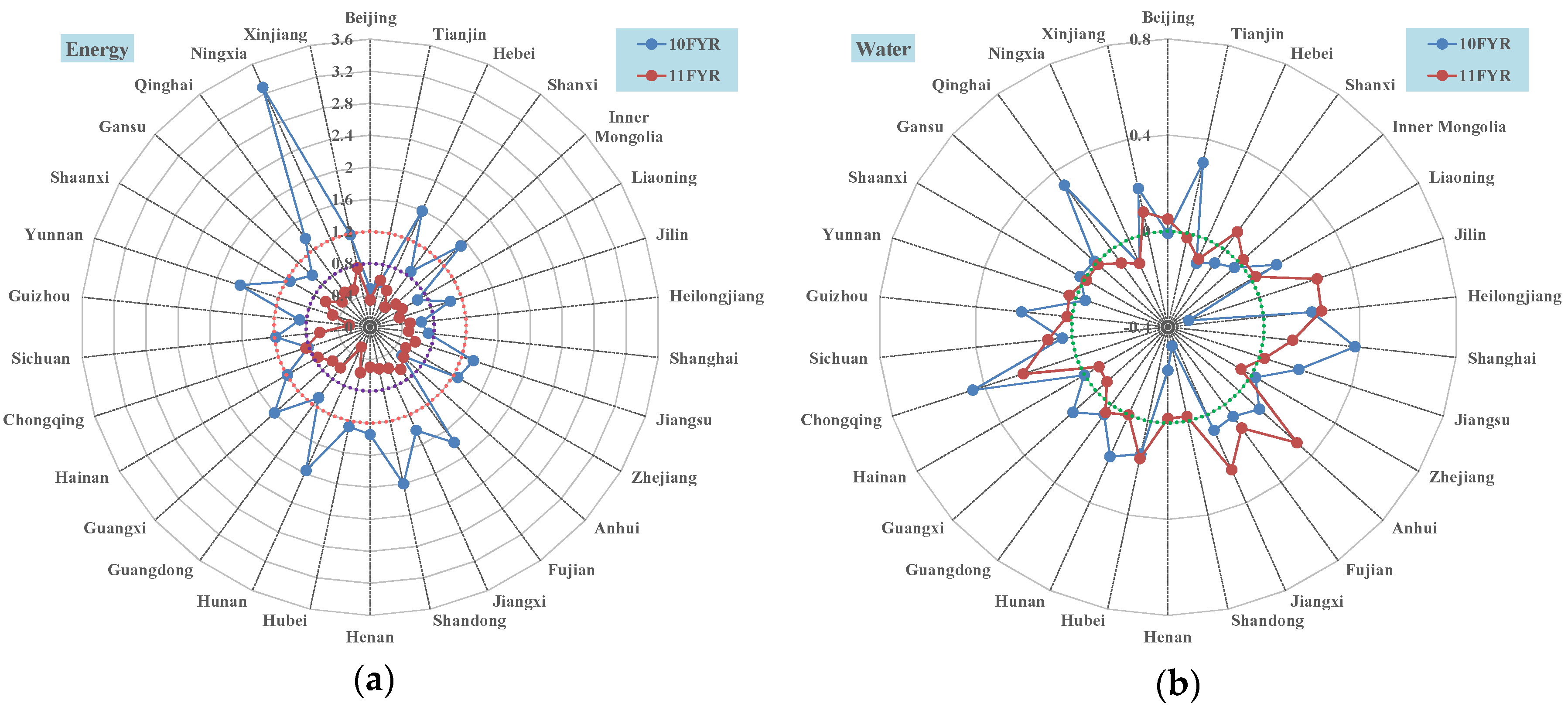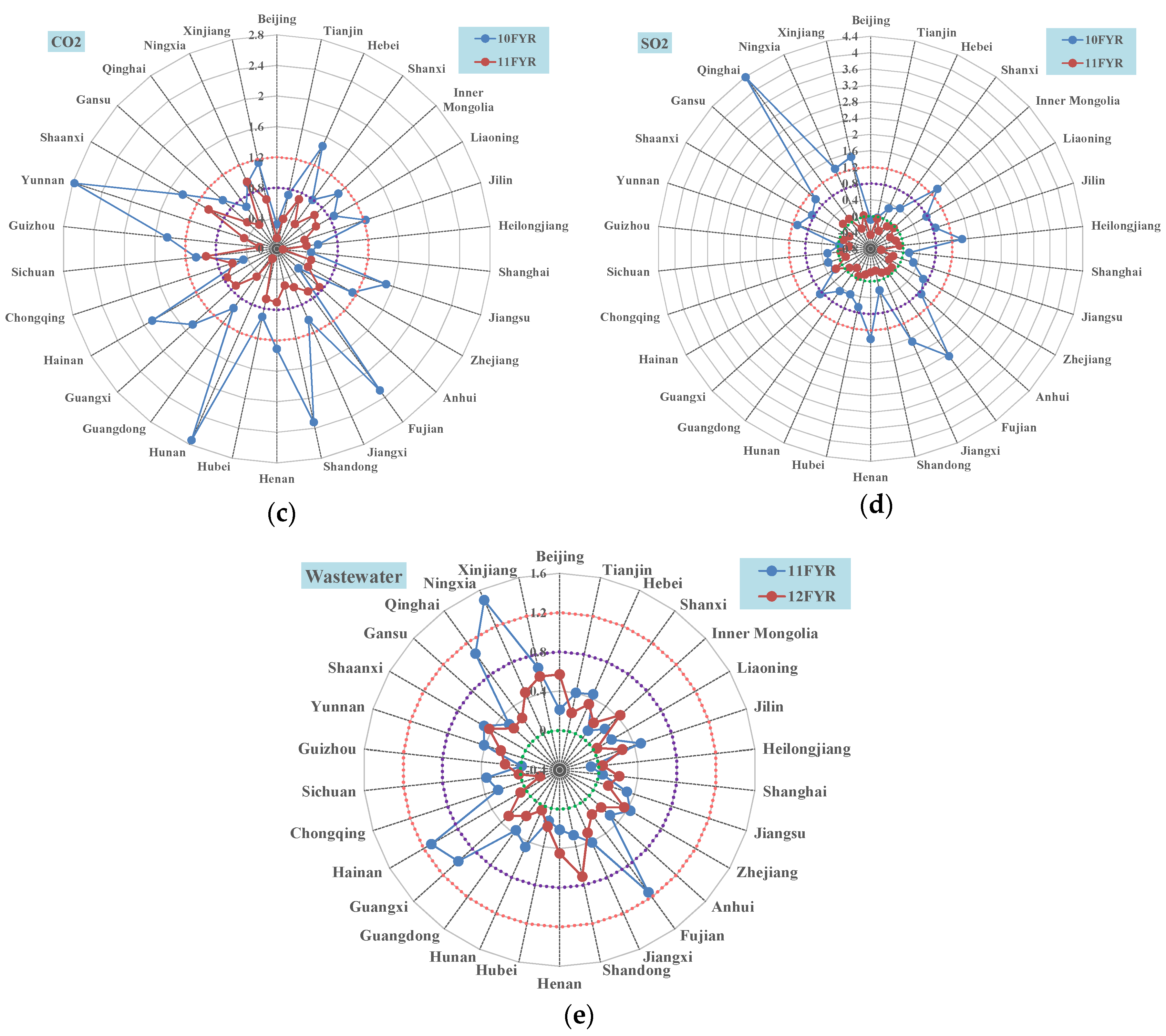The Decoupling of Resource Consumption and Environmental Impact from Economic Growth in China: Spatial Pattern and Temporal Trend
Abstract
:1. Introduction
2. Methodology and Data
2.1. Decoupling Analysis
2.2. Hurst Exponent
2.3. Data Sources
3. Results and Discussion
3.1. Decoupling Performance
3.2. Trend Analysis of Decoupling Performance
4. Conclusions
Supplementary Materials
Acknowledgments
Author Contributions
Conflicts of Interest
References
- United Nations Environment Programme (UNEP). Decoupling Natural Resource Use and Environmental Impacts from Economic Growth; A Report of the Working Group on Decoupling to the International Resource Panel; Fischer-Kowalski, M., Swilling, M., von Weizsäcker, E.U., Ren, Y., Moriguchi, Y., Crane, W., Krausmann, F., Eisenmenger, N., Giljum, S., Hennicke, P., et al., Eds.; UNEP: Nairobi, Kenya, 2011. [Google Scholar]
- Zhang, N.; Lior, N.; Jin, H.G. The energy situation and its sustainable development strategy in China. Energy 2011, 36, 3639–3649. [Google Scholar] [CrossRef]
- International Energy Agency (IEA). World Energy Outlook 2009; IEA: Paris, France, 2006. [Google Scholar]
- Chen, X.P.; Pang, J.X.; Zhang, Z.L.; Li, H.J. Sustainability assessment of solid waste management in China: A decoupling and decomposition analysis. Sustainability 2014, 6, 9268–9281. [Google Scholar] [CrossRef]
- Li, D.H.W.; Yang, L.; Lam, J.C. Zero energy buildings and sustainable development implications—A review. Energy 2013, 54, 1–10. [Google Scholar] [CrossRef]
- Liang, S.; Liu, Z.; Crawford-Brown, D.; Wang, Y.; Xu, M. Decoupling Analysis and Socioeconomic Drivers of Environmental Pressure in China. Environ. Sci. Technol. 2013, 48, 1103–1113. [Google Scholar] [CrossRef] [PubMed]
- Liu, J.; Diamond, J. Science and government—Revolutionizing China’s environmental protection. Science 2008, 319, 37–38. [Google Scholar] [CrossRef] [PubMed]
- Liu, J.G.; Diamond, J. China’s environment in a globalizing world. Nature 2005, 435, 1179–1186. [Google Scholar] [CrossRef] [PubMed]
- Organisation for Economic Co-operation and Development (OECD). Indicators to Measure Decoupling of Environmental Pressure from Economic Growth; OECD: Pairs, France, 2002. [Google Scholar]
- Wang, H.M.; Hashimoto, S.; Yue, Q.; Moriguchi, Y.; Lu, Z.W. Decoupling Analysis of Four Selected Countries: China, Russia, Japan, and the United States during 2000–2007. J. Ind. Ecol. 2013, 17, 618–629. [Google Scholar] [CrossRef]
- Zhang, Z.; Chen, X.; Heck, P.; Xue, B.; Liu, Y. Empirical study on the environmental pressure versus economic growth in China during 1991–2012. Resour. Conserv. Recycl. 2015, 101, 182–193. [Google Scholar] [CrossRef]
- Grossman, G.M.; Krueger, A.B. Economic-growth and the environment quarterly. J. Econ. 1995, 110, 353–377. [Google Scholar]
- Marin, G.; Mazzanti, M. The evolution of environmental and labor productivity dynamics. J. Evol. Econ. 2013, 23, 357–399. [Google Scholar] [CrossRef]
- Aoki-Suzuki, C. Exploring potential policy motivation and approaches to improve resource efficiency in emerging Asia. J. Mater. Cycles Waste Manag. 2016, 18, 57–71. [Google Scholar] [CrossRef]
- Recalde, M.Y.; Guzowski, C.; Zilio, M.I. Are modern economies following a sustainable energy consumption path? Energy Sustain. Dev. 2014, 19, 151–161. [Google Scholar] [CrossRef]
- Bithas, K.; Kalimeris, P. Re-estimating the decoupling effect: Is there an actual transition towards a less energy-intensive economy? Energy 2013, 51, 78–84. [Google Scholar] [CrossRef]
- Zhang, Y.; Yang, Q.S. Decoupling agricultural water consumption and environmental impact from crop production based on the water footprint method: A case study for the Heilongjiang land reclamation area, China. Ecol. Indic. 2014, 43, 29–35. [Google Scholar]
- Gilmont, M. Decoupling dependence on natural water: Reflexivity in the regulation and allocation of water in Israel. Water Policy 2014, 16, 79–101. [Google Scholar] [CrossRef]
- Zhang, M.; Wang, W.W. Decouple indicators on the CO2 emission-economic growth linkage: The Jiangsu Province case. Ecol. Indic. 2013, 32, 239–244. [Google Scholar] [CrossRef]
- Wang, W.W.; Liu, R.; Zhang, M.; Li, H.A. Decomposing the decoupling of energy-related CO2 emissions and economic growth in Jiangsu Province. Energy Sustain. Dev. 2013, 17, 62–71. [Google Scholar] [CrossRef]
- Lenzen, M.; Schaeffer, R.; Karstensen, J.; Peters, G.P. Drivers of change in Brazil’s carbon dioxide emissions. Clim. Chang. 2013, 121, 815–824. [Google Scholar] [CrossRef]
- Andreoni, V.; Galmarini, S. Decoupling economic growth from carbon dioxide emissions: A decomposition analysis of Italian energy consumption. Energy 2012, 44, 682–691. [Google Scholar] [CrossRef]
- De Freitas, L.C.; Kaneko, S. Decomposing the decoupling of CO2 emissions and economic growth in Brazil. Ecol. Econ. 2011, 70, 1459–1469. [Google Scholar] [CrossRef]
- Zhang, Z.X. Decoupling China’s carbon emissions increase from economic growth: An economic analysis and policy implications. World Dev. 2000, 28, 739–752. [Google Scholar] [CrossRef]
- Ichinose, D.; Yamamoto, M.; Yoshida, Y. The decoupling of affluence and waste discharge under spatial correlation: Do richer communities discharge more waste? Environ. Dev. Econ. 2015, 20, 161–184. [Google Scholar] [CrossRef]
- Amann, M.; Klimont, Z.; Wagner, F. Regional and global emissions of air pollutants: Recent trends and future scenarios. Ann. Rev. Environ. Resour. 2013, 38, 31–55. [Google Scholar] [CrossRef]
- Jorgenson, A.K.; Clark, B. Are the Economy and the Environment Decoupling? A Comparative International Study, 1960–2005. Am. J. Sociol. 2012, 118, 1–44. [Google Scholar] [CrossRef]
- Tapio, P. Towards a theory of decoupling: Degrees of decoupling in the EU and the case of road traffic in Finland between 1970 and 2001. Transp. Policy 2005, 12, 137–151. [Google Scholar] [CrossRef]
- Van Caneghem, J.; Block, C.; van Hooste, H.; Vandecasteele, C. Eco-efficiency trends of the Flemish industry: Decoupling of environmental impact from economic growth. J. Clean. Prod. 2010, 18, 1349–1357. [Google Scholar] [CrossRef]
- Yu, Y.D.; Chen, D.J.; Zhu, B.; Hu, S.Y. Eco-efficiency trends in China, 1978–2010: Decoupling environmental pressure from economic growth. Ecol. Indic. 2013, 24, 177–184. [Google Scholar] [CrossRef]
- Diakoulaki, D.; Mandaraka, M. Decomposition analysis for assessing the progress in decoupling industrial growth from CO2 emissions in the EU manufacturing sector. Energy Econ. 2007, 29, 636–664. [Google Scholar] [CrossRef]
- Brizga, J.; Feng, K.S.; Hubacek, K. Drivers of CO2 emissions in the former Soviet Union: A country level IPAT analysis from 1990 to 2010. Energy 2013, 59, 743–753. [Google Scholar] [CrossRef]
- Wang, K.M. The relationship between carbon dioxide emissions and economic growth: Quantile panel-type analysis. Qual. Quant. 2013, 47, 1337–1366. [Google Scholar] [CrossRef]
- Steinberger, J.K.; Krausmann, F.; Getzner, M.; Schandl, H.; West, J. Development and dematerialization: An international study. PLoS ONE 2013, 8, 11. [Google Scholar] [CrossRef] [PubMed]
- Andersson, F.N.G.; Karpestam, P. CO2 emissions and economic activity: Short- and long-run economic determinants of scale, energy intensity and carbon intensity. Energy Policy 2013, 61, 1285–1294. [Google Scholar] [CrossRef]
- Zhang, L.M.; Xue, B.; Geng, Y.; Ren, W.X.; Lu, C.P. Emergy-based city’s sustainability and decoupling assessment: Indicators, features and findings. Sustainability 2014, 6, 952–966. [Google Scholar] [CrossRef]
- Peng, J.; Liu, Z.H.; Liu, Y.H.; Wu, J.S.; Han, Y.A. Trend analysis of vegetation dynamics in Qinghai-Tibet Plateau using Hurst Exponent. Ecol. Indic. 2012, 14, 28–39. [Google Scholar] [CrossRef]
- Katsev, S.; L’Heureux, I. Are Hurst exponents estimated from short or irregular time series meaningful? Comput. Geosci. 2003, 29, 1085–1089. [Google Scholar] [CrossRef]
- Deng, W.B.; Li, W.; Cai, X.; Wang, Q.P.A. Self-similarity and network perspective of the Chinese fund market. Phys. A 2011, 390, 3826–3834. [Google Scholar] [CrossRef]
- Mishra, A.K.; Ozger, M.; Singh, V.P. An entropy-based investigation into the variability of precipitation. J. Hydrol. 2009, 370, 139–154. [Google Scholar] [CrossRef]
- Li, Q.H.; Chen, Y.N.; Shen, Y.J.; Li, X.G.; Xu, J.H. Spatial and temporal trends of climate change in Xinjiang, China. J. Geogr. Sci. 2011, 21, 1007–1018. [Google Scholar] [CrossRef]
- Granero, M.A.S.; Segovia, J.E.T.; Perez, J.G. Some comments on Hurst exponent and the long memory processes on capital markets. Phys. A 2008, 387, 5543–5551. [Google Scholar] [CrossRef]
- Xu, J.H.; Lu, Y.; Su, F.L.; Al, N.S. R/S and wavelet analysis on evolutionary process of regional economic disparity in china during past 50 years. Chin. Geogr. Sci. 2004, 14, 193–201. [Google Scholar] [CrossRef]
- Sakalauskienė, G. The Hurst phenomenon in hydrology. Environ. Res. Eng. Manag. 2003, 3, 16–20. [Google Scholar]
- Wang, Y.Z.; Li, B.; Wang, R.Q.; Su, J.; Rong, X.X. Application of the Hurst exponent in ecology. Comput. Math. Appl. 2011, 61, 2129–2131. [Google Scholar] [CrossRef]
- Parmar, K.S.; Bhardwaj, R. Water quality index and fractal dimension analysis of water parameters. Int. J. Environ. Sci. Technol. 2013, 10, 151–164. [Google Scholar] [CrossRef]
- Zhang, Z.; Liu, Z.; Chen, X.; Lu, C.; Xue, B. The evolutionary trend of CO2 emissions and its spatial differentiation in China: Based on R/S Method. Econ. Geogr. 2013, 33, 20–25. (In Chinese) [Google Scholar]
- Weng, Y.C.; Chang, N.B.; Lee, T.Y. Nonlinear time series analysis of ground-level ozone dynamics in Southern Taiwan. J. Environ. Manag. 2008, 87, 405–414. [Google Scholar] [CrossRef] [PubMed]
- Guan, D.B.; Liu, Z.; Geng, Y.; Lindner, S.; Hubacek, K. The gigatonne gap in China’s carbon dioxide inventories. Nat. Clim. Chang. 2012, 2, 672–675. [Google Scholar] [CrossRef]
- Gu, A.; Teng, F.; Wang, Y. China energy-water nexus: Assessing the water-saving synergy effects of energy-saving policies during the eleventh Five-year Plan. Energy Convers. Manag. 2014, 85, 630–637. [Google Scholar] [CrossRef]
- Geng, Y.; Wang, M.; Sarkis, J.; Xue, B.; Zhang, L.; Fujita, Y.; Yu, X.; Ren, W.; Zhang, L.; Dong, H. Spatial-temporal patterns and driving factors for industrial wastewater emission in China. J. Clean. Prod. 2014, 76, 116–124. [Google Scholar] [CrossRef]
- Wang, Z.W. China’s wastewater treatment goals. Science 2012, 338, 604. [Google Scholar] [CrossRef] [PubMed]
- Couillard, M.; Davison, M. A comment on measuring the Hurst exponent of financial time series. Phys. A 2005, 348, 404–418. [Google Scholar] [CrossRef]



| Regions | Energy | Water | CO2 | SO2 | Wastewater | |||||
|---|---|---|---|---|---|---|---|---|---|---|
| 11FYR | 12FYR | 11FYR | 12FYR | 11FYR | 12FYR | 11FYR | 12FYR | 11FYR | 12FYR | |
| Standard deviation | 0.564 | 0.137 | 0.182 | 0.113 | 0.650 | 0.234 | 0.892 | 0.153 | 0.370 | 0.191 |
| Regions | Energy | Water | CO2 | SO2 | Wastewater | |||||
|---|---|---|---|---|---|---|---|---|---|---|
| a | H | a | H | a | H | a | H | a | H | |
| Beijing | 0.002 | 0.803 | 0.009 | 0.603 | −0.029 | 0.512 | −0.058 | 0.640 | 0.007 | 0.582 |
| Tianjin | 0.028 | 0.691 | −0.035 | 0.691 | 0.005 | 0.480 | −0.069 | 0.506 | −0.013 | 0.558 |
| Hebei | −0.014 | 0.797 | 0.023 | 0.529 | 0.028 | 0.780 | −0.015 | 0.690 | 0.032 | 0.608 |
| Shanxi | 0.008 | 0.799 | 0.074 | 0.752 | −0.011 | 0.765 | −0.022 | 0.740 | 0.070 | 0.504 |
| Inner Mongolia | −0.021 | 0.637 | 0.017 | 0.580 | 0.035 | 0.646 | −0.087 | 0.695 | 0.048 | 0.662 |
| Liaoning | 0.022 | 0.432 | −0.029 | 0.761 | 0.077 | 0.547 | 0.000 | 0.618 | 0.051 | 0.608 |
| Jilin | 0.057 | 0.725 | 0.102 | 0.940 | 0.107 | 0.698 | 0.019 | 0.624 | 0.034 | 0.422 |
| Heilongjiang | 0.062 | 0.885 | 0.029 | 0.475 | 0.085 | 0.841 | −0.052 | 0.860 | 0.081 | 0.830 |
| Shanghai | −0.018 | 0.775 | −0.094 | 0.636 | −0.054 | 0.598 | −0.234 | 0.812 | −0.001 | 0.622 |
| Jiangsu | 0.019 | 0.871 | −0.030 | 0.600 | 0.050 | 0.782 | −0.109 | 0.728 | −0.050 | 0.500 |
| Zhejiang | −0.027 | 0.804 | −0.022 | 0.575 | 0.016 | 0.847 | −0.075 | 0.970 | −0.045 | 0.590 |
| Anhui | 0.019 | 0.913 | 0.002 | 0.604 | 0.031 | 0.578 | −0.042 | 0.931 | 0.063 | 0.556 |
| Fujian | −0.020 | 0.826 | −0.014 | 0.569 | −0.033 | 0.703 | −0.167 | 0.837 | −0.131 | 0.605 |
| Jiangxi | 0.012 | 0.716 | −0.010 | 0.543 | 0.041 | 0.879 | −0.126 | 0.816 | 0.038 | 0.599 |
| Shandong | 0.003 | 0.840 | 0.054 | 0.571 | 0.003 | 0.951 | 0.017 | 0.637 | 0.049 | 0.787 |
| Henan | −0.025 | 0.766 | 0.066 | 0.424 | 0.051 | 0.811 | −0.109 | 0.902 | 0.026 | 0.879 |
| Hubei | 0.034 | 0.827 | 0.014 | 0.395 | 0.074 | 0.782 | −0.053 | 0.866 | 0.028 | 0.674 |
| Hunan | 0.033 | 0.908 | −0.025 | 0.847 | 0.123 | 0.815 | −0.077 | 0.800 | 0.020 | 0.734 |
| Guangdong | −0.011 | 0.941 | −0.031 | 0.714 | −0.007 | 0.804 | −0.225 | 0.861 | 0.001 | 0.473 |
| Guangxi | 0.031 | 0.881 | −0.001 | 0.742 | 0.064 | 0.800 | −0.287 | 0.549 | −0.097 | 0.764 |
| Hainan | −0.006 | 0.740 | −0.015 | 0.321 | −0.260 | 0.502 | 0.087 | 0.583 | −0.045 | 0.754 |
| Chongqing | −0.025 | 0.721 | −0.074 | 0.900 | 0.004 | 0.829 | 0.015 | 0.866 | −0.002 | 0.607 |
| Sichuan | 0.030 | 0.766 | 0.034 | 0.785 | 0.123 | 0.727 | −0.244 | 0.620 | −0.133 | 0.594 |
| Guizhou | 0.006 | 0.547 | −0.067 | 0.758 | −0.040 | 0.687 | −0.008 | 0.890 | 0.139 | 0.753 |
| Yunnan | 0.032 | 0.948 | 0.015 | 0.551 | 0.094 | 0.558 | −0.037 | 0.510 | 0.136 | 0.571 |
| Shaanxi | 0.042 | 0.851 | 0.011 | 0.613 | 0.120 | 0.831 | −0.037 | 0.803 | 0.031 | 0.769 |
| Gansu | −0.004 | 0.749 | −0.005 | 0.515 | 0.062 | 0.612 | −0.107 | 0.730 | 0.092 | 0.501 |
| Qinghai | −0.029 | 0.448 | −0.118 | 0.564 | −0.021 | 0.459 | −0.166 | 0.904 | −0.033 | 0.759 |
| Ningxia | 0.098 | 0.541 | 0.000 | 0.589 | −0.087 | 0.855 | −0.015 | 0.731 | −0.199 | 0.607 |
| Xinjiang | 0.037 | 0.846 | 0.022 | 0.682 | 0.090 | 0.837 | 0.064 | 0.575 | 0.019 | 0.504 |
© 2016 by the authors; licensee MDPI, Basel, Switzerland. This article is an open access article distributed under the terms and conditions of the Creative Commons by Attribution (CC-BY) license (http://creativecommons.org/licenses/by/4.0/).
Share and Cite
Zhang, Z.; Xue, B.; Pang, J.; Chen, X. The Decoupling of Resource Consumption and Environmental Impact from Economic Growth in China: Spatial Pattern and Temporal Trend. Sustainability 2016, 8, 222. https://doi.org/10.3390/su8030222
Zhang Z, Xue B, Pang J, Chen X. The Decoupling of Resource Consumption and Environmental Impact from Economic Growth in China: Spatial Pattern and Temporal Trend. Sustainability. 2016; 8(3):222. https://doi.org/10.3390/su8030222
Chicago/Turabian StyleZhang, Zilong, Bing Xue, Jiaxing Pang, and Xingpeng Chen. 2016. "The Decoupling of Resource Consumption and Environmental Impact from Economic Growth in China: Spatial Pattern and Temporal Trend" Sustainability 8, no. 3: 222. https://doi.org/10.3390/su8030222








